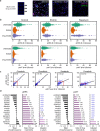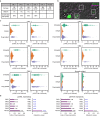Ultrasensitive proteomic quantitation of cellular signaling by digitized nanoparticle-protein counting
- PMID: 27320899
- PMCID: PMC4913309
- DOI: 10.1038/srep28163
Ultrasensitive proteomic quantitation of cellular signaling by digitized nanoparticle-protein counting
Abstract
Many important signaling and regulatory proteins are expressed at low abundance and are difficult to measure in single cells. We report a molecular imaging approach to quantitate protein levels by digitized, discrete counting of nanoparticle-tagged proteins. Digitized protein counting provides ultrasensitive molecular detection of proteins in single cells that surpasses conventional methods of quantitating total diffuse fluorescence, and offers a substantial improvement in protein quantitation. We implement this digitized proteomic approach in an integrated imaging platform, the single cell-quantum dot platform (SC-QDP), to execute sensitive single cell phosphoquantitation in response to multiple drug treatment conditions and using limited primary patient material. The SC-QDP: 1) identified pAKT and pERK phospho-heterogeneity and insensitivity in individual leukemia cells treated with a multi-drug panel of FDA-approved kinase inhibitors, and 2) revealed subpopulations of drug-insensitive CD34+ stem cells with high pCRKL and pSTAT5 signaling in chronic myeloid leukemia patient blood samples. This ultrasensitive digitized protein detection approach is valuable for uncovering subtle but important differences in signaling, drug insensitivity, and other key cellular processes amongst single cells.
Figures





Similar articles
-
Rationally designed aberrant kinase-targeted endogenous protein nanomedicine against oncogene mutated/amplified refractory chronic myeloid leukemia.Mol Pharm. 2012 Nov 5;9(11):3062-78. doi: 10.1021/mp300172e. Epub 2012 Oct 5. Mol Pharm. 2012. PMID: 22971013
-
Bcr-Abl expression levels determine the rate of development of resistance to imatinib mesylate in chronic myeloid leukemia.Cancer Res. 2005 Oct 1;65(19):8912-9. doi: 10.1158/0008-5472.CAN-05-0076. Cancer Res. 2005. PMID: 16204063
-
Subcellular distribution of p210(BCR-ABL) in CML cell lines and primary CD34+ CML cells.Leukemia. 2008 Mar;22(3):559-71. doi: 10.1038/sj.leu.2405057. Epub 2007 Dec 6. Leukemia. 2008. PMID: 18059481
-
Apoptosis in chronic myeloid leukemia cells transiently treated with imatinib or dasatinib is caused by residual BCR-ABL kinase inhibition.Am J Hematol. 2013 May;88(5):385-93. doi: 10.1002/ajh.23419. Epub 2013 Mar 27. Am J Hematol. 2013. PMID: 23420553
-
Cotreatment with vorinostat (suberoylanilide hydroxamic acid) enhances activity of dasatinib (BMS-354825) against imatinib mesylate-sensitive or imatinib mesylate-resistant chronic myelogenous leukemia cells.Clin Cancer Res. 2006 Oct 1;12(19):5869-78. doi: 10.1158/1078-0432.CCR-06-0980. Clin Cancer Res. 2006. PMID: 17020995
Cited by
-
Ex Vivo Analysis of Primary Tumor Specimens for Evaluation of Cancer Therapeutics.Annu Rev Cancer Biol. 2021 Mar;5:39-57. doi: 10.1146/annurev-cancerbio-043020-125955. Epub 2020 Dec 8. Annu Rev Cancer Biol. 2021. PMID: 34222745 Free PMC article.
References
-
- Mann M., Hendrickson R. C. & Pandey A. Analysis of proteins and proteomes by mass spectrometry. Annu Rev Biochem 70, 437–473 (2001). - PubMed
-
- Twyman R. Principles Of Proteomics. Garland Science (2013).
-
- Paradela A. & Albar J. P. Advances in the Analysis of Protein Phosphorylation. Journal of proteome research 7, 1809–1818 (2008). - PubMed
Publication types
MeSH terms
Substances
Grants and funding
LinkOut - more resources
Full Text Sources
Other Literature Sources
Medical
Miscellaneous

